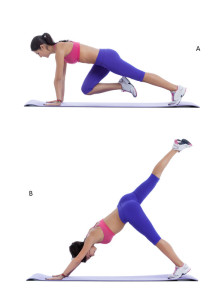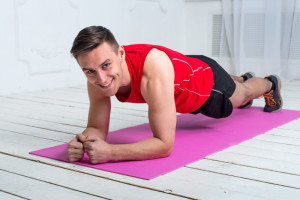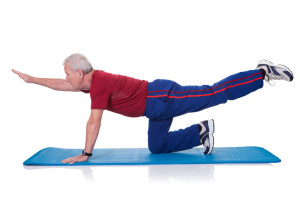Nearly forty years ago I had a lumbar laminectomy and three vertebrae fused together caused by degenerative issues from accidents on horses and tractors (I rolled a tractor and it came back on top of me) so I have some idea about lower back pain and how debilitating it can be.

The one thing I have learnt from all of this is the ongoing need to keep your core and abs strong and flexible (whether you have a crook back or not). If I stop doing my exercise routine for more than a couple of months I end up a proper cot case but keep the program going and I have no trouble at all. Another good example of “use it or lose it”. Probably why some of my mates at the gym call me the “core king”.
The core muscles are like the knot that ties our upper and lower body together. Like a tree – it is your trunk or the strongest part of the tree and it is the central link connecting the limbs to the roots. They are deep muscle layers which are divided into two groups lying close to the spine providing structural support for the whole of your body.
Our core muscles are used virtually every time we move and often in ways you probably never even realized or thought about. Functional everyday movements are highly dependent on your core as it stabilizes the trunk and pelvis which allows your arms and legs to move correctly with activity. This is what we might call dynamic core function.
But we also have something else called static core functionality. Static in this case meaning resisting a force that doesn’t change. Like when you are standing watching your young son play a game of football. It doesn’t feel like you are doing much but it does require a good degree of core stability which is also one of the hardest things to train for.
So you can see, your core needs to be strong as well as flexible and the only way you can achieve this is by regular exercise. The only way to get core strength is with dedicated training. Unfortunately, relying on drugs to relieve pain from an inactive body is not a good long term option.
A weak core not only throws out our balance and posture, which is extremely important as you get older, but it can prevent us from doing many simple everyday tasks such as tying our shoes or the most basic jobs around the home like taking the wheelie bin out.
Keep in mind a “strong core” does not mean you have 6-pack abs, it simply means your core is strong enough to support your daily level of normal every day activities and functionality.
Daily tasks that require a strong core
Every single day, even if you do not workout, you are doing something that engages your core muscles. Basic activities, such as, putting on your shoes, looking behind you when driving, getting dressed, even sitting down/standing up all activate your core muscles.
These are activities we take for granted and do naturally but without decent core strength, these basic tasks will become difficult and/or painful.
Work related tasks that require a strong core
The most obvious core-engaging jobs are construction, fitness instructor, and any job that requires an extensive amount of lifting, bending, and twisting. These tasks are very difficult without a strong core.
However, those of you who sit at a desk for hours on end are still engaging your core (but not in the best way). Sitting answering phone calls, using the computer and other similar tasks is very hard on your lower lumbar as well as your circulation so make sure you get up every hour and do a few stretches. Prolonged sitting combined with lack of exercise can also cause premature death.
Sports and Your Core
The bending and twisting actions of most popular activities such as tennis, golf, football, swimming, surfing and boxing all require a strong core which control these motions. A weak core will lead to injury, tire you out faster and prevent you from playing to the best of your ability.
What You Can Do About Your Core Strength
Have you found yourself experiencing side cramps or having a hard time bending or lifting? You will benefit from a stronger core and there are so many ways to go about getting those muscles fired up.
• Work out your entire core! When people think “core muscles” the first thing that comes to mind is their abs, but there is much more to your core than just abs. You also have to engage your back muscles, which are very important to everyday living. Nobody wants back pain every time you bend down to pick up the newspaper or chase your kid around the yard.
• Practice standing up straight. Many people do not realize how good posture actually engages the core and helps to fight fat build up. Slouching can cause damage to your back muscles and prevent proper core engagement.
• Eat healthy! I know, I know, this is the most overstated piece of information, but it really is the most important. All that exercising is nothing without the proper nutrients. You need to feed your body plenty of protein (preferably form actual food and not a powder) as well as drink lots of water. Fruits and vegetables are also crucial for proper bowel movement, aim for at least 4 to 5 different fruits/vegetables per day.
5+ Core Engaging Exercises I do on a Regular Basis
This is not meant to be a definitive core workout – it is just a few exercises that work well for me and is a good place for you to get started. If you are not sure how to do any of the exercises either ask a personal trainer or find them on YouTube.
Make sure when doing any exercises you warm up and your form is perfect and if you have hip, knee or any other medical problems like high blood pressure then get a clearance from your family doctor first before starting a core exercise program.
A quick word of warning. For lower lumbar longevity steer clear of sit-ups and crunches regardless of what you read in magazines and what others may tell you.
Dr. Stuart McGill, who I and many others regard very highly, is a professor of spine biomechanics at the University of Waterloo (Waterloo, ON, Canada) and in an interview on SportsRehabExpert.com he said if you “do enough sit-ups, does not matter who you are, you will hurt your discs. Think of the low back like a credit card, if you keep bending it back and forth, it will eventually break. Some people may have more “bending cycles” but the principle is the same for all.”

So go ahead and try these three times a week:
1. Planks. Planking is a great low impact core exercise that engages nearly every muscle in your body and as you progress with your fitness there are many different planks you can move up to with increased degrees of difficulty.
2. Bridges and Swiss Ball Jacknives. Forward facing, side and with leg lift – bridges target the lower abdominal muscles, glutes, thigh muscles, and lower back. Can be done on a floor mat or using a Swiss ball.

3. Birddog. Hold for 7 to 8 seconds on each side. The back extensors (both the lumbar and thoracic are important) and are challenged with the birddog.
4. Lunges. Forward, reverse and side.
5. Ab wheel roll-outs and hanging knee raises. If you don’t own an ab wheel then buy one. They are cheap to buy and are one of the best core exercises you can do. If you haven’t done these before only roll out as far as you feel comfortable and do the exercise up against a wall so you don’t roll out too far and hurt your back.
For some more good core exercises download the free PDF from Princeton University Athletic Medecine: Lumbar/Core Strength and Stability Exercises. They provide a Lumbar/Core Strength and Stability Program which can be utilized as a preventative rehabilitation program or if you are recovering from an injury. The program includes a flexibility and strengthening section. I recommend you have a look at it.
Having a strong core can really change the way you live your life.
Take some time every day to put in a workout. Even if it’s just 20 minutes three times a week you will notice a huge difference within a month to six weeks. And remember, once you start – don’t stop.
Let me know how you go or if you need some help.
Leave a Reply